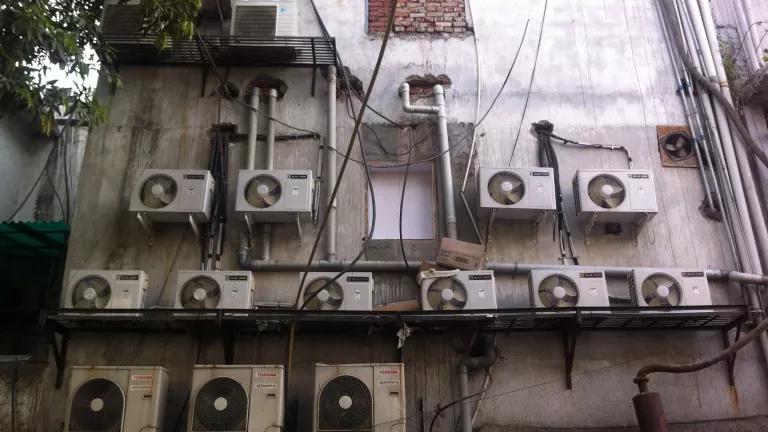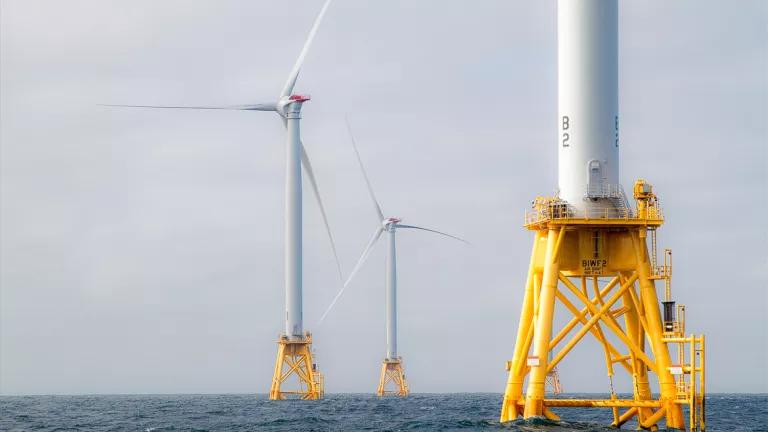The Unexpectedly Exciting World of Refrigerants
Cooling equipment packs a potent climate threat: invisible refrigerant gases that leak into the atmosphere during the equipment’s operating lifetime. The very chemicals that will help billions of people adapt to extreme heat are themselves driving the climate crisis.

The view from East Rock Park, from lush forest to a bustling downtown.
Guest blog written by Tilden Chao. Tilden is an undergraduate at Yale University who worked on NRDC’s HFC policy team in the summer of 2021. On campus, Tilden directs the Yale Refrigerants Initiative, a project aimed at developing refrigerant management solutions on university campuses.
Atop East Rock, a trap rock cliff in my home of New Haven, Connecticut, every part of the city is visible at once. Brown office buildings give way to docks and freight carriers on Long Island Sound. Silver smokestacks from Sterling Power Plant rise out of red brick buildings below. Interstate-95, bustling with cars and semi-trucks, encircles the city like a concrete necklace.
The view from East Rock also reveals smaller features of industrialization. White aluminum air conditioning units speckle rooftops and windows across the city, blasting cool air into office buildings, schools, and apartments. Power plant chillers generate chilled water that flows through the walls of Yale New Haven Hospital, keeping patients and doctors cool in the summer heat. Refrigerated trucks and warehouses form a link in the American cold chain, bringing fresh food and safe vaccines to our community. Even more equipment lies out of sight: kitchen refrigerators, car air conditioners, and supermarket display cases.
All this cooling equipment packs a potent climate threat: invisible refrigerant gases that leak into the atmosphere during the equipment’s operating lifetime. These refrigerants, such as hydrofluorocarbons (HFCs) and hydrochlorofluorocarbons (HCFCs), are super-pollutants with thousands of times the global warming potential of carbon dioxide. They are used all over the world. Climate damage from these chemicals is the highest in the near term, increasing the likelihood of triggering tipping points in the climate system.
HFCs are also the fastest-growing climate pollutant in the world. Phasing down HFC use and preventing HFC emissions during equipment operations can prevent 0.5 degree Celsius of warming by the end of the century — a critical chunk of abatement needed to achieve the Paris Agreement’s 1.5-degree warming limit.
The United States and hundreds of other countries have committed to phasing down HFCs under the Kigali Amendment to the Montreal Protocol. But HFCs continue to be used in cooling equipment across the globe, including in our very own homes and office buildings. These chemicals are not going away anytime soon.
In late July, as extreme heat and wildfires gripped the West Coast, the sky in New Haven turned orange. Smoke dimmed the afternoon sun. I shut my apartment windows and cranked up the air conditioning. In the Pacific Northwest, people struggled to find any air conditioners left on the shelf. Extreme heat has killed hundreds of people in the United States this summer and is killing low-income people of color at disproportionately high rates.
As the world warms, demand for air conditioning is projected to quadruple worldwide. Rising living standards and per capita income in developing countries will also drive global demand for cooling. The very chemicals that will help billions of people adapt to extreme heat are themselves driving the climate crisis.
When I was 16 years old, I learned that Project Drawdown’s climate solutions report ranked refrigerant management and climate-friendly refrigerants as the top solutions to halt and reverse climate change. I loved birds and marine life and understood that the earth needed robust solutions to climate change and fierce defenders of the environment. But I had little knowledge of greenhouse gases beyond what I could see spewing out of tailpipes and smokestacks.
That changed when Sustainable Tompkins, a citizen climate organization in my hometown of Ithaca, New York, opened its Youth Climate Challenge. With a friend, I applied for a grant to learn more about refrigerant usage in town and to encourage our local food retailers and restaurants to develop plans to phase down HFCs.
Three years later, I’m living out a dream of working on NRDC’s HFC policy team. In my free time, I direct a student initiative at Yale to better manage HFCs on college campuses. As I look back on my summer at NRDC, I’m sharing some of the reasons why the world of refrigerants has been so unexpectedly exciting.
Changing how the public thinks about refrigerants could be a game changer.
The market treats HFCs as commodities when HFCs are truly super-pollutants. Throughout the United States, you can walk into Walmart and buy a small can of HFC refrigerant, as easily as you might buy a can of soda at the convenience store. People buy small cans of HFC to work on do-it-yourself projects such as maintenance on car air conditioners. Online, 25-pound disposable cylinders of HFC—supposedly legal for sale only to licensed technicians—can be purchased by anyone with a credit card. The residual refrigerant remaining in these cylinders after use is released into the atmosphere. These refrigerant cylinders, unlike cans of soda, are not recyclable.
Refrigerant gases also aren’t priced to account for their climate damage. A 12-ounce can of HFC-134A retails for $6, but if emitted, has equivalent warming effects as more than 1 ton of carbon dioxide over a 20-year period. The social cost of these emissions—the monetary damage of emissions to the world at large—would be as high as $78 based on my calculations derived from the Environmental Protection Agency’s estimates.
The high global warming potential (GWP) of HFCs headlines most conversations about refrigerants. But the principal cause of climate damage from HFCs is our failure to manage and contain these gases during their lifetime, from production to disposal. Technology exists to detect and eliminate HFC leaks across the globe, yet leak rates are as high as 25 percent annually in the food retail industry and 10 percent annually in home air conditioners. Historically, it has been more profitable for industry to invent new refrigerant gases than to contain existing ones.
Everyone can play a role in driving the market away from HFCs.
A few interesting takeaways:
- Consumers can play important roles in reducing demand for HFCs by purchasing refrigerators that use climate-friendly refrigerants such as R-600A (isobutane) and R-290 (propane). These refrigerators are now available at big box stores at competitive prices.
- Refrigerant emissions from residential air conditioning units make up about a third of annual HFC emissions in the United States, according to NRDC’s modeling. Emissions from this equipment alone are equivalent to the annual climate pollution of 39 coal-fired power plants (based on a 20-year GWP). Window air conditioners are now in stores using R-32, a climate-friendlier refrigerant, with more energy-efficient and climate-friendlier options on the way. Consumers' dollars can accelerate the market’s adoption of climate-friendlier refrigerants.

Me in front of two central air conditioning units, each containing about 7 pounds of R-410A, a potent HFC. R-410A is 4,340 times more potent than carbon dioxide over a 20-year period.
As a student living in a dorm room, I have a limited ability to drive change with my own pocketbook. Instead, I contribute to projects that raise awareness about HFCs and influence how other people choose to spend their money. NRDC’s colleagues at the Environmental Investigation Agency (EIA) run a community science program aimed at gathering data on refrigerant use in American supermarkets. These data fuel grassroots campaigns that pressure corporations to adopt climate-friendly refrigerants. Food retailers have historically not been transparent in the types of refrigerants used in stores.
EIA has created a map of supermarkets across the globe that highlights supermarkets using climate-friendly refrigerants. You can join me in poking your head in supermarket refrigerators, taking pictures of the equipment’s identifying information, and helping to expand this database.
Even with the incoming phasedown of HFCs, the HFC problem isn’t solved.
In December 2020, Congress passed the American Innovation and Manufacturing (AIM) Act, which gave EPA authority to phase down HFCs nationwide. Although the AIM Act will reduce HFC emissions significantly by 2050, it does not amount to a ban on HFC use in the near term. Retailers can still sell older models of refrigerators and air conditioners that use HFCs, and products that have already been sold—many of which are in our homes—can operate for decades.
Even though EPA prohibits the intentional release of refrigerant into the atmosphere, enforcement of this rule has been unsuccessful. Refrigerant loss during equipment disposal remains a serious problem. According to estimates from the California Air Resources Board, 77 percent of refrigerant in household refrigerators is lost to the atmosphere at equipment end of life. For window air conditioners, the loss rate is 98.5 percent.
Refrigerant loss at end of life is not only a legal and environmental problem, but also a missed economic opportunity.
Service technicians have the technology to recover used refrigerant into pressurized cylinders. Specialized facilities can then refurbish recovered refrigerant and resell it to consumers, in a process known as refrigerant reclamation. Even though used refrigerant is a valuable material, it is often vented and lost into the atmosphere. Instead, reclaiming it would reduce demand for new, “virgin,” refrigerant creating opportunities for policymakers to accelerate the phasedown of HFCs.
Addressing refrigerants is a win for humans and for all life on earth.
I hiked East Rock again last weekend, taking time to admire its oak-hickory forests and the peregrine falcons and black vultures flying overhead. Our work on HFCs often feels far removed from this natural world, instead occupying supermarket aisles, mechanical rooms, and meeting rooms on Capitol Hill. But this work, from containing HFCs in the present to accelerating their phasedown in the future, is one of our best shots at halting climate change and reducing the environmental impact of climate adaptation.



